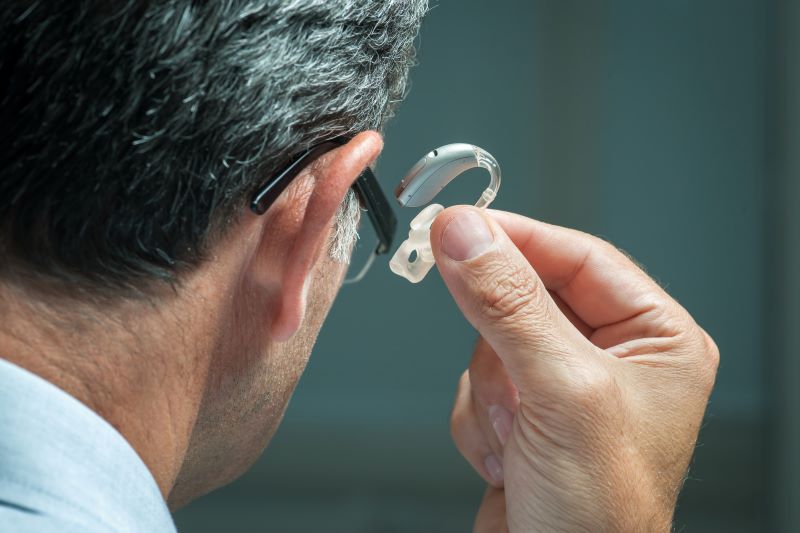Your hearing aids, like many other high-end electronic devices, work their best when they’re clean and free from obstructions. The effects of COVID-19 mean you might not be able to see your hearing care professional as often as you’d like for a professional cleaning.
Let the experts at Colorado Ear Care show you how you can care for and clean your devices safely and effectively during the pandemic, or even just between your regularly scheduled professional cleanings so that they always perform their best for your hearing needs.
Whenever we fit patients with hearing aids, one of the first things that we share with them is how to clean their devices. No matter what type of hearing aid you might wear, whether it is a behind-the-ear (BTE), receiver-in-the-canal (RIC), or in-the-ear (ITC) style device, there’s an opportunity to ensure that it stays clean. The difference lies in what aspects of the device you’ll be cleaning.
Because these pieces of technology are making contact with our bodies all day long (you are wearing your hearing aids all day long, aren’t you?), the sweat and oil they produce are collecting on them, and can cause them to perform sub-optimally.
One of the biggest culprits in decreasing device performance is earwax (often referred to by hearing care professionals as “cerumen”). Earwax can get trapped in the domes and tubing, causing obstructions that hinder proper device performance. Other debris like dust and dead skin cells can inhibit microphones from picking up the sounds you’re trying to hear.
Though we recommend that our patients get their hearing aids professionally cleaned and examined twice a year by the practice (a service that we safely offer during COVID), we also encourage all hearing aid wearers to develop a regular habit of cleaning their devices at home.
How often? Well, it really depends. Some bodies naturally produce oil and earwax with greater frequency than others. If that describes your body chemistry, then you might consider cleaning them on a daily basis. If your body’s production of these materials is less-so, then a weekly cleaning may suffice. You’re the best judge of this.
At minimum, a weekly do it yourself (DIY) cleaning should help to keep your devices pristine and their performance high.
A standard part of our offerings at Colorado Ear Care is providing our hearing aid patients cleaning kits for their devices. Depending on the type of device, this will include items like a brush affixed that has a small loop on its opposite end. This loop is called a wax loop and is, you guessed it, designed to carefully remove wax buildup from certain device components.
These kits will also often feature a small microfiber cloth (similar to those used for cleaning eyeglasses) that are designed for wiping away oil and other buildup or debris.
Some of our patients ask if they should use water or rubbing alcohol when cleaning their devices, and our strong recommendation is to use neither. Why? Moisture can cause catastrophic damage to your hearing aids (remember they’re basically small computers!) and, despite how quickly rubbing alcohol evaporates, you still run the risk of harming your hearing aids by using this as a cleaning agent.
The components in your cleaning kits should be more than appropriate for most day to day cleanings, and if you feel that they are not then perhaps it is time to schedule a professional cleaning instead.
DIY at-home cleaning and care tips for your hearing aids:
- First, either turn the hearing aid off or remove the batteries from your hearing aids. Not doing so can cause feedback or whistling while you clean.
- Gently use the brush end of your cleaning tools to remove any debris or buildup on the dome or earmold. Use the same tool to gently clean your hearing aids’ microphone. If you don’t know what your hearing aids’ microphone looks like, refer to your user manual. They are located on the body of the device, and, depending on the brand, will look like a small black circle, a single rectangular slot, or multiple rectangular slots.
- Many hearing aids are made with “wax guards” that attach to the end of the hearing aid. They are designed to block wax and debris from entering into the hearing aid. These wax guards are easily changed by you, the user. The exact method of changing the wax guard is dependent on the hearing aid manufacturer. There is an example of how to change the wax guard in the video that accompanies this article.
- Use the microfiber cloth to wipe off your hearing aid dome as well as the hearing aid casing. Do this several times to remove all buildup.
- Turn the hearing aid back on or place the battery back inside the hearing aid.
- You have now successfully cleaned your hearing aids. Great job! Through this simple process, you’re prolonging the life and improving the performance of your hearing devices.
Other important tips for cleaning your hearing aids:
- If you wear BTE hearing aids, take note of how your tubing is holding up. These components, while durable, can become brittle and cracked over time. In many cases, poor device performance can be attributed to bad tubes. We can quickly and easily assess this during your professional device cleaning appointments.
- Though there’s not a specific time you should be cleaning your devices, we do recommend cleaning them at night after you’ve removed them. This allows you to remove any earwax, buildup, or debris before it has dried onto the technology overnight.
The better you can be at taking care of your devices, the better they’ll take care of you! And don’t forget to schedule professional cleanings at least twice a year so we can evaluate your technology, use professional tools to give them a thorough cleaning, and provide answers to any questions that you might have. That’s what the Colorado Ear Care team is here for — to help you hear your best!

